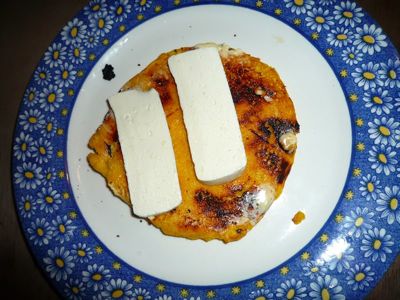If one travels to Colombia, it is most likely that between 3 and 6 pm that one will be invited to eat “something.” Being served a combination of coffee or hot chocolate along with a wide variety of baked goods has become a ritual for many Colombian families during the time of the day when the sun sets.
In Reticente [es], the blog of Juan David Escobar, he writes about that tradition that has been passed down by many generations:
Mis abuelas nos enseñaron que a eso de las 3pm, se debe parar la vida para comer algo caliente con parva, o lo que te encuentres, pero comer “algo”.
More often that not, this “something” is an arepa. On a cold afternoon, Escobar participated in the preparation of arepas of chócolo (soft corn), and which is something also discussed in other Colombian blogs. The Blog de Colombia [es] provides an explanation about the process to prepare the arepa:
La arepa es una de las comidas más típicas en Colombia. Para hacerlas, los ingredientes son muy básicos: harina de diferentes tipos de maíz, agua, aceite y sal. Luego está el relleno, que cada uno puede hacer de lo que quiera, pero la arepa pura es lo importante. Aunque todavía no se pongan de acuerdo sobre qué país es el originario, la arepa colombiana tiene su propia tradición y forma de elaboración.
The arepa of chócolo is made after threshing the corn, as indicated by the blog Recetas de Cocina, Colombia Turística [es]:
Se desgranan los chócolos, y se muelen. Debe quedar una masa suave. Se arman las arepas y se ponen a asar sobre una hoja de plátano, luego se voltean sobre una hoja nueva, hasta que queden bien asados por ambos lados.
The arepa of chócolo is accompanied with cheese [es]:
Si quiere puede hacer dos cosas con el queso: cortarlo en lajitas, cortar la arepa por el borde e introducir el queso en la mitad y asarlas de nuevo por un minuto o rallar el queso y mezclarlo, con la masa, antes de armarlas.
Blogger Carlos Múnera of the blog Somos Iguales [es] affirms:
Qué cosa más rica es ese binomio culinario de la arepa de chócolo* con quesito y mejor cuando se forma aquel triángulo amoroso a la llegada de un espumoso chocolate en leche. Sí señores, ah fríos que nos ha quitado ese trinomio de sabor. Ah tardes que nos han acompañado paralelo a una buena visita parviada*. Cuán sencillos y humanos nos sentimos cuando comemos del fruto de la tierra cocido al calor del fuego.
Finally, Escobar of the blog El Reticente [es] concludes his post:
Mientras los ordenes económicos y de seguridad se mueven y la ciudad crece y se moderniza, todavía por aquí tenemos las tradiciones más clásicas, a pesar de que de las abuelas ni los huesos quedan.









4 comments
I never got invited… :)
do you like one? just visit us ;)
good post!
I must admit that I don’t like the arepas very much, but arepas of chócolo (soft corn) are very very delicious, especially with cheese and butter… I like one right now ;)
cheers!